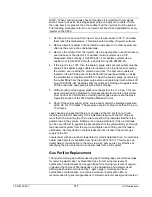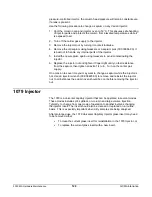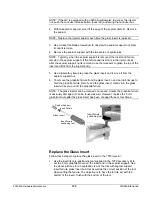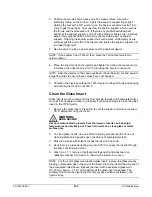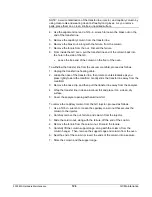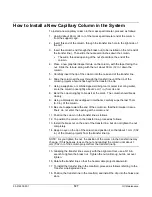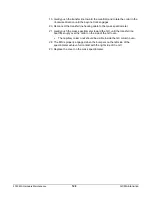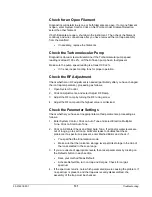
03-914978-00:1
117
GC Maintenance
NOTE: When conducting leak check procedures it is important to completely
seal all carrier gas exits, including septum purge and split vent outlets. If more
than one injector is present, then the outlets of all the injectors must be sealed.
The following procedure refers to one injector but should be duplicated for every
injector on the 3800.
1. Set the column oven and the injector zone temperatures to 50 °C and allow
them reach this temperature. This allows safe handling of injector surfaces.
2. Remove injector septum nut and install a new septum. An older septum can
often be the source of a substantial leak.
3. Remove the column from the injector. Use the appropriate nut and ferrules to
seal the base of the injector. For packed column systems use a 1/4
″
Swagelok
blank off plug (16-000154-00). For capillary systems use a
capillary nut (03-949551-00) with a no hole ferrule (28-694590-01).
4. If the injector is a 1079, then the septum purge and split vent outlets must be
sealed. The septum purge outlets are located on the top frame surrounding
the column oven, behind the column oven door. The split vent outlets are
located on the left side panel of the 3800 with manual pneumatics or inside
the pneumatics compartment with EFC. Seal the septum purge by removing
the outlet fitting from the septum purge valve and replacing it with a blank off
plug (16-000154-00). Seal the split vent outlet by installing a Swagelok union
on the outlet tube and sealing it with a blank off plug.
5. With all outlet ports plugged, pressurize the system to 20 - 30 psi. This can
be accomplished by adjustment of manual pneumatic controls or Electronic
Flow Control. For information on setting carrier gas pressure see the Basic
Operation section of the 3800 Getting Started manual.
6. Shut off the carrier supply at the source and monitor the displayed pressure
at the GC for 15 minutes. The pressure should not drop more than 0.5 psi in
15 minutes.
Leak checking ensures that there are no leaks in the GC system up to and
including the injector assembly. If the indicated pressure on the GC drops by
more than 0.5 psi during the 15-minute test period, this indicates that there is a
positive leak in the system. Finding such a leak, particularly if it is a small leak,
can be very difficult. In general the best approach is to systematically go through
the pneumatic system from the source and tighten each fitting until the leak is
eliminated. It is important to note that leaks are often found in the carrier gas
supply to the GC.
Locate leaks with an electronic leak detector or leak detection fluid. An electronic
helium leak detector is available from Varian (01-900153-01). This device can
detect helium concentration in the air as low as 2 ppm and is very effective at
identifying the precise location of a helium leak from a GC system.
Gas Purifier Replacement
The most common gas purifiers used in gas chromatography are moisture traps
for removing water vapor, hydrocarbon traps for removing low levels of
hydrocarbon contaminants and oxygen traps for removing low levels of oxygen.
In general the choice of filter depends on the application and detector used.
Carrier gas should contain less than 1-ppm oxygen, moisture and trace
hydrocarbon contaminants. A combined moisture / hydrocarbon filter is
recommended for general applications to maintain detector background levels at















